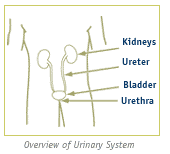Why Some Children are Unable to Hold their Urine
In some cases, inability to control urine (incontinence) is caused by problems in the body. For example, nerve damage that occurs with spina bifida. Children who cannot control their bladder need special help in learning how to take care of themselves by managing their bladder habits through the use of catheters. A catheter is a hollow plastic tube inserted into the urethra to empty the bladder.
Overview of Urinary System
 To better understand incontinence, let’s review how a child’s urinary system functions. A urinary system consists of five major parts: two kidneys, two ureters, the bladder, a sphincter muscle and the urethra. The kidneys filter our blood and produce urine, which flows down the ureters into the bladder. Urine is then held in the bladder, which is like a muscular bag, by a strong circular muscle band called a sphincter muscle. When the brain sends a message to relax the sphincter muscle, the urine is released and flows down the urethra and out of the body. The bladder sends a signal to the brain when it is full, about every 3 – 4 hours, then the brain decides whether or not it is a convenient time to empty. If the bladder cannot contract when the brain tells it to empty, then it will become overfilled. An overfilled bladder may damage the kidneys. Urine can even “back up” into the kidney.
To better understand incontinence, let’s review how a child’s urinary system functions. A urinary system consists of five major parts: two kidneys, two ureters, the bladder, a sphincter muscle and the urethra. The kidneys filter our blood and produce urine, which flows down the ureters into the bladder. Urine is then held in the bladder, which is like a muscular bag, by a strong circular muscle band called a sphincter muscle. When the brain sends a message to relax the sphincter muscle, the urine is released and flows down the urethra and out of the body. The bladder sends a signal to the brain when it is full, about every 3 – 4 hours, then the brain decides whether or not it is a convenient time to empty. If the bladder cannot contract when the brain tells it to empty, then it will become overfilled. An overfilled bladder may damage the kidneys. Urine can even “back up” into the kidney.
Children whose bladder, sphincter muscle, and/or message to and from the brain do not work correctly, may experience urinary problems. The bladder may overfill with urine and become distended. Catheterization keeps the bladder from leaking when it is distended or overfilled.
Intermittent Self-Catheters
With just a little practice, most children can easily learn to use the system themselves. Many children as young as four or five have been taught self-catheterization.
The method involves the periodic insertion of a hollow plastic tube into the urethra, past the sphincter muscle and into the bladder. Because the catheter is hollow, urine will flow through it and the bladder will empty. This process must be done at regular intervals and is most effective if done on a set schedule each day.
Advantages and Health Benefits of Intermittent Catheterization
- It prevents the bladder from becoming overfilled and losing its muscle tone.
- It eliminates the problem of urine that remains in the bladder even after it has emptied.
- By completely emptying the bladder, the intermittent catheter decreases the amount of wetting accidents, allowing a child to enjoy a more active, confident and healthy lifestyle.
How often a child should self-cathertize: Normally, catheterization is performed every four hours. It can be done more frequently, but your child should never go more than four hours without being catheterized. It is not necessary to catheterize during the night.
How to clean catheters: Catheters should be cleaned with gentle soap and warm water after each use, allowed to dry and stored in a sealed container out of sunlight.
How long can a catheter be used?: A catheter can be used for years as long as it is cleaned and stored properly. Check for signs of damage before each use.
Tips for school-aged children who use catheters:
- Prepare a kit of supplies needed to cath, catheters, lubricant, a wash cloth and soap, paper towels and a change of clothes (just in case).
- Take extra catheters just in case one gets dropped on the floor.
- Back packs are a good storage place for the supplies.
- Bathrooms are dirty or inaccessible? Catheterize before school and then go home for lunch and cath a second time there.
- Wear clothes that are easy to take on and off.
Bladder Infections
It is believed that most bladder infections are caused by incomplete emptying of the bladder. In some cases, damage to the kidneys may result. With regular, complete emptying of the bladder, bacterial growth can be prevented and a child’s kidneys and bladder can be protected from infection and disease.
Drink Plenty of Fluids
Sometimes children with bladder control problems will reduce the amount that they drink in order to prevent accidents. Children should drink plenty of fluids during the day. The continuous flushing of the bladder will help decreased the chances that the child will develop a bladder infection.